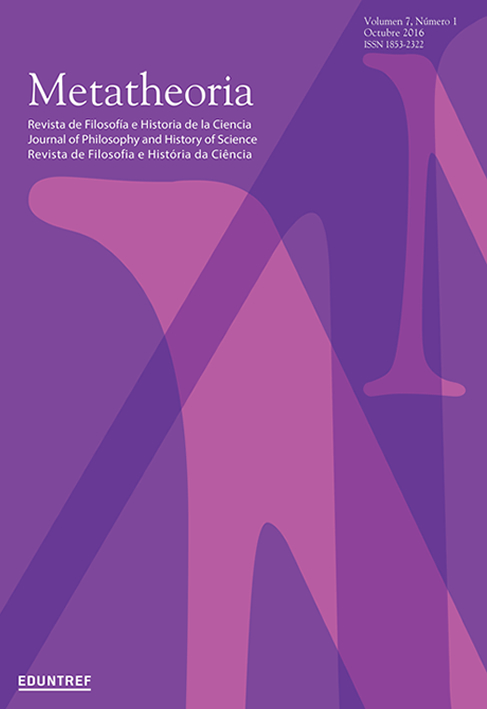Los modelos y la ficción
DOI:
https://doi.org/10.48160/18532330me7.254Palavras-chave:
modelos, ficción, pretensión, verdad en la ficción, concepción semántica de las teorías, concepción estructuralista de los modelosResumo
La mayoría de los modelos científicos no son objetos físicos y esto origina cuestiones importantes. ¿Qué clase de entidad son los modelos?, ¿qué es la verdad en un modelo? Y ¿cómo aprendemos sobre los modelos? En este escrito, argumento que los modelos tienen importantes aspectos en común con la ficción literaria y que, por tanto, las teorías de la ficción pueden aplicarse a estas cuestiones. En particular, argumento que la teoría de la simulación como la desarrolla Walton (1990, Mimesis as Make-believe: On the Foundations of the Representational Arts, Cambridge, MA: Harvard University Press) tiene los recursos para responder a estas cuestiones. Introduzco esta explicación, perfilo las respuestas que ofrece y desarrollo una imagen general del modelado científico basado en ella.
Referências
Bogen, J. y J. Woodward (1988), “Saving the Phenomena”, Philosophical Review97: 303-352.
Brown, J.R. (1999), Philosophy of Mathematics. An Introduction to the World of Proofs and Pictures, London: Routledge.
Budd, M. (1992), “Review of ‘Mimesis as Make-Believe’”, Mind 101: 195-198.
Cartwright, N. (1983), How the Laws of Physics Lie, Oxford: Oxford University Press.
Cartwright, N. (1999), The Dappled World. A Study of the Boundaries of Science, Cambridge: Cambridge University Press.
Cat, J. (2001), “On Understanding: Maxwell on the Methods of Illustration and Scientific Metaphor”, Studies in History and Philosophy of Science 32(3): 295-441.
Crittenden, C. (1991), Unreality. The Metaphysics of Fictional Objects, Ithaca and London: Cornell University Press.
Currie, G. (1990), The Nature of Fiction,Cambridge: Cambridge University Press.
Currie, G. (2004), “Imagination and Make-Believe”, en Gaut, B. y D. McIver Lopes (eds.), The Routledge Companion to Aesthetics, London: Routledge, pp. 355-346.
Davies, D. (2007), “Thought Experiments and Fictional Narratives”, Croatian Journal of Philosophy 7(19): 29-45.
Edgeworth, F.Y. (1881), Mathematical Psychics: An Essay on the Application of Mathematics to the Moral Sciences, London: Kegan Paul.
Elgin, C.Z. (1996), Considerate Judgement, Princeton: Princeton University Press.
Evans, G. (1982), The Varieties of Reference(ed.por John McDowell), Oxford: Oxford University Press.
Fine, A. (1993), “Fictionalism”, Midwest Studies in Philosophy 18: 1-18.
French, S. y J. Ladyman (1997), “Reinflating the Semantic Approach”, International Studies in the Philosophy of Science 13: 103-121.
Friend, S. (2007), “Fictional Characters”, Philosophy Compass 2(2): 141-156.
Frigg, R. (2003), Re-presenting Scientific Representation, Tesis doctoral, London: University of London.
Frigg, R. (2006), “Scientific Representation and the Semantic View of Theories”, Theoria 55: 49-65.
Giere, R.N. (1988), Explaining Science. A Cognitive Approach, Chicago: Chicago University Press.
Godfrey-Smith, P. (2006), “The Strategy of Model-Based Science”, Biology and Philosophy21: 725-740.
Hartmann, S. (1999), “Models and Stories in Hadron Physics”, en Morgan, M. y M. Morrison (eds.), Models as Mediators. Perspectives on Natural and SocialScience, Cambridge: Cambridge University Press, pp. 326-346.
Howell, R. (1979), “Fictional Objects: How they Are and How they Aren’t”, Poetics 8: 129-177.
Hughes, R.I.G. (1997), “Models and Representation”, Philosophy of Science (Proceedings)64: 325-336.
Kivy, P. (2006), Performance of Reading: An Essay in the Philosophy of Literature, Oxford: Blackwell.
Lamarque, P. (1991), “Essay Review of ‘Mimesis as Make-Believe: On the Foundations of the Representational Arts’by Kendall Walton”, Journal of Aesthetics and Art Criticism49(2): 161-166.
Lamarque, P. y S.H. Olsen (1994), Truth, Fiction, and Literature, Oxford: Clarendon Press.
Lewis, D. (1978), “Truth in fiction”, en Lewis, D. (ed.), Philosophical Papers, Volume I, Oxford: Oxford University Press, 1983, pp. 261-280.
McCloskey, D.N. (1990), “Storytelling in Economics”, en Nash, C. (ed.), Narrartive in Culture. The Uses of Storytelling in the Sciences, Philosophy, andLiterature, London: Routledge, pp. 5-22.
Morgan, M. (2001), “Models, Stories and the Economic World”, Journal of Economic Methodology 8(3): 361-384.
Morgan, M. (2004), “Imagination and Imaging in Model Building”, Philosophy of Science 71(4): 753-766.
Parsons, T. (1980), Nonexistent Objects, New Haven: Yale University Press.
Russell, B. (1919), Introduction to Mathematical Philosophy, London/New York: Routledge, 1993.
Russell, B. (1905), “On Denoting”, en Russell, B.,Logic and Knowledge, London: Routledge, 1956, pp. 39-56.
Shapiro, S. (1983), “Mathematics and Reality”, Philosophy of Science 50: 523-548.
Shapiro, S. (1997), Philosophy of Mathematics. Structure and Ontology, New York: Oxford University Press.
Smolin, L. (2007), The Trouble with Physics: The Rise of String Theory, the Fall of a Science and What comes Next, London: Allen Lane.
Sugden, R. (2000), “Credible Worlds: The Status of Theoretical Models in Economics”, Journal of Economic Methodology 7(1): 1-31.
Suppes, P. (1960), “A Comparison of the Meaning and Uses of Models in Mathematics and the Empirical Sciences”, en Suppes. P. (ed.), Studies in the Methodology and Foundations of Science. Selected Papers from 1951 to 1969, Dordrecht: Reidel,1969, pp. 10-23.
Teller, P. (2001), “Whither Constructive Empiricism”, Philosophical Studies 106: 123-150.
Thomson-Jones, M. (2007), “Missing Systems and the Face Value Practice”, Synthesedoi:10.1007/s11229-009-9507-y.
Vaihinger, H. ([1911] 1924), The Philosophy of ‘As If’, London: Kegan Paul.
van Fraasen, B.C. (1997), “Structure andPerspective: Philosophical Perplexity and Paradox”, en Dalla Chiara, M.L. (ed.), Logic and Scientific Methods, Dordrecht: Kluwer, pp. 511-530.
Volterra, V. (1926), “Fluctuations in the Abundance of a Species considered Mathematically”, Nature 118: 558-560.
Walton, K.L. (1990), Mimesis as Make-Believe: On the Foundations of the Representational Arts, Cambridge, MA: Harvard University Press.
Weisberg, M. (2007), “Who is a Modeler?”, British Journal for Philosophy of Science58: 207-233.
Wigner, E. (1960), “The Unreasonable Effectiveness of Mathematics in the Natural Sciences”, Communications on Pure and Applied Mathematics 13: 1-14.
Young, H. y R. Freedman (2000), University Physics. With Modern Physics, 10ª ed., San Francisco/Reading, MA: Addison-Wesley.
Downloads
Publicado
Como Citar
Edição
Seção
Licença
Copyright (c) 2020 Metatheoria – Revista de Filosofia e História da CiênciaOs documentos publicados aqui são regidos pelos critérios de licenciamento Creative Commons Argentina.Atribución - No Comercial - Sin Obra Derivada 2.5





